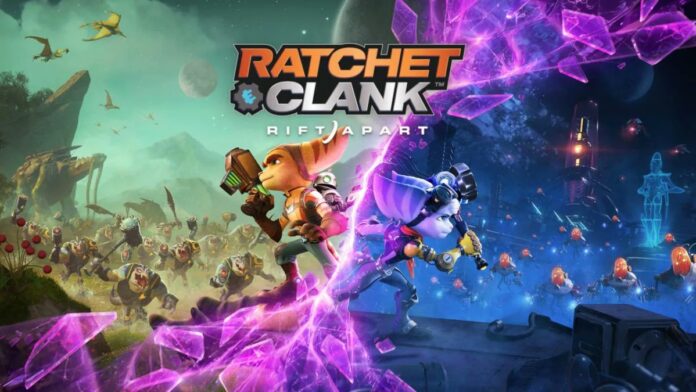Che tempo per essere vivi cantano i Fall Out Boy in uno dei pezzi più riusciti del loro ultimo album. Una celebrazione sarcastica di una situazione mondiale non esattamente positiva, che, se ascoltata con poca attenzione, potrebbe quasi sembrare una ballata allegra. Guardando alla situazione videoludica, si potrebbe quasi dire: che bel momento per essere un giocatore PC. Grazie all’apertura sempre più ampia di Sony al gaming su computer, sembra essere finalmente un buon periodo per mettere da parte la rivalità tra console e unirsi sotto la bandiera del PC. Dopo titoli come Uncharted, The Last of Us e molti altri, è finalmente arrivata anche l’opportunità di vedere Ratchet & Clank: Rift Apart fuori dall’ecosistema PlayStation. Un gioco che, grazie all’acclamato utilizzo dell’SSD potente della PS5, sembrava destinato a rimanere esclusivo per i fortunati possessori della console. Tuttavia, da qualche giorno è disponibile anche su Steam ed Epic Games Store. Ma questa conversione è all’altezza delle aspettative o la PS5 rimane comunque il posto migliore dove vivere le avventure del simpatico duo?
Prima di addentrarci nelle prestazioni e nel rendimento di Ratchet & Clank: Rift Apart su PC, è importante soffermarsi sulla qualità del gioco in sé. Se avete già giocato alla versione PS5, potete passare oltre, poiché non troverete nulla di nuovo in questa versione. Se invece state affrontando per la prima volta l’ultimo capitolo della celebre saga, sarà un piacere scoprire che si tratta di un ottimo gioco. Come avevamo sottolineato nella nostra recensione, è “un’opera di grande valore, con il gameplay adrenalinico che ha reso famoso lo studio americano, insieme a un’atmosfera da film d’animazione, in grado di conquistare praticamente ogni tipo di giocatore.” Ratchet & Clank: Rift Apart è quindi un gioco riuscito, fresco e divertente, caratterizzato anche da un aspetto tecnico di primissimo piano. Un ottimo biglietto da visita per le caratteristiche della PlayStation 5 e che finalmente è disponibile anche su PC.
Abbiamo provato Ratchet & Clank: Rift Apart su un computer con Intel Core i5 8600K, Nvidia GeForce RTX 3070, 16 GB di RAM e un SSD NVMe con velocità di lettura fino a 3400 MB/s. Una configurazione superiore a quella consigliata, che prevede un Intel Core i5-8400 o AMD Ryzen 5 3600, 16 GB di RAM, una NVIDIA GeForce RTX 2060 o AMD Radeon RX 5700 e un SSD per sfruttare al meglio le caratteristiche del gioco. Durante i nostri test abbiamo variato numerose volte le impostazioni di gioco per valutare il lavoro di Nixxes nel modo più ampio possibile. Alla fine, abbiamo giocato con i dettagli al massimo, che, nonostante il nome, non sono il massimo della qualità, ma sono equiparabili ai dettagli alti di altri titoli, e con una risoluzione Quad HD, cioè 2560×1440. Abbiamo provato sia con il ray tracing disattivato che al massimo, ottenendo un framerate superiore ai 60 fps nella maggior parte del gioco senza ray tracing e tra i 45 e i 50 fps con ray tracing al massimo. L’attivazione del DLSS ha migliorato ulteriormente il framerate, consentendo un incremento significativo in molte situazioni. Abbiamo riscontrato alcuni cali significativi di framerate durante le sezioni più concitate, ma niente di troppo frequente. Abbiamo anche avuto alcuni crash occasionali durante le dieci ore di gioco, indicando che ci sono ancora alcuni problemi tecnici da risolvere. Con future patch e correzioni, si spera che questi problemi possano essere risolti o almeno mitigati, anche se al momento attuale non influiscono troppo sull’esperienza di gioco complessiva.
Dal punto di vista visivo, Ratchet & Clank: Rift Apart è davvero bello da vedere su PC, con una configurazione adeguata e con il supporto completo per gli effetti RTX. Grazie a questi effetti, il gioco raggiunge un livello visivo superiore rispetto alla versione PS5. Tuttavia, l’ammiraglia Sony ha ancora un vantaggio significativo con l’SSD. Anche se con l’NVMe che abbiamo utilizzato siamo riusciti a ottenere prestazioni simili a quelle della console, i tempi di caricamento tra i portali sono ancora migliori su PlayStation 5. Se il gioco viene installato su un SSD meno veloce o addirittura su un hard disk, il divario diventa ancora più evidente, sebbene non influisca in modo significativo nell’esperienza di gioco complessiva. Quindi, sì, è possibile giocare a Ratchet & Clank: Rift Apart anche senza un SSD di fascia alta.
Le impostazioni grafiche di Ratchet & Clank: Rift Apart su PC sono di ottimo livello. Nel menu dedicato è possibile personalizzare diversi aspetti dell’esperienza di gioco. Oltre ai classici parametri di qualità delle texture, anti-aliasing, sincronizzazione verticale e profondità di campo, ci sono diverse opzioni che aumentano le possibilità di personalizzazione. È possibile regolare la qualità dei riflessi, degli effetti particellari, la densità del traffico e la qualità dei capelli. La maggior parte di queste opzioni è regolabile su sei diversi livelli, da basso ad ultra. È anche possibile attivare o disattivare alcuni effetti visivi come il tremolio della visuale e l’aberrazione cromatica. Nixxes ha fatto un ottimo lavoro rendendo Ratchet & Clank: Rift Apart adattabile a diverse configurazioni e esigenze.
In conclusione, così come era un ottimo gioco su PS5, Ratchet & Clank: Rift Apart è anche un ottimo gioco su PC, grazie al completo supporto degli effetti RTX che migliorano notevolmente l’aspetto visivo. Alcuni problemi tecnici, come i cali di framerate, influiscono solo parzialmente su una conversione che comunque ha molto da offrire. Quindi, se stavate aspettando di giocarlo, ora non avete più scuse.
Ratchet & Clank Rift Apart | La dura legge del SSD | Recensione [PC]
I Fall Out Boy sing “What a time to be alive” in one of the most successful tracks from their latest album. It’s a sarcastic celebration of a not-so-rosy global situation, which, if listened to with little attention, could almost seem like a cheerful ballad. Taking this more optimistic and gaming perspective, one could almost say: what a time to be a PC gamer. Thanks to Sony’s increasing openness to gaming on computers, it now seems like a good time to finally set aside the console war and unite under the PC flag. After Uncharted, The Last of Us, and many others, it is finally time to see Ratchet & Clank Rift Apart in action outside of the PlayStation ecosystem. A title that, thanks to the highly touted use of the powerful SSD of PS5, seemed destined to be exclusive to fortunate Sony flagship owners, but instead arrived on Steam and Epic Games Store a few days ago. Has this port shown its value, or is PS5 still the best place to enjoy the adventures of the lovable duo? First and foremost, it’s a good game. Before diving into the performance and visuals of Ratchet & Clank Rift Apart on PC, it is important to focus on the quality of the gameplay. If you have already played it on PS5, you can skip ahead, as this version of the game does not offer anything new in terms of gameplay. However, if it’s your first time approaching the latest chapter of the famous saga, you’ll be pleased to know that it’s a very good game. As we mentioned in our review, it’s “a new high-quality work, with the adrenaline-filled gameplay that made the American studio famous, along with an atmosphere reminiscent of an animated film that can win over practically any user.” In short, Ratchet & Clank Rift Apart is a successful, fresh, and fun game, also characterized by outstanding technical aspects. A great showcase for the features of the PlayStation 5, and now finally available on PC. Between frame rate and ray tracing, we tested Ratchet & Clank Rift Apart on a computer equipped with an Intel Core i5 8600K, Nvidia GeForce RTX 3070, 16GB of RAM, and an NVMe SSD with reading speeds of up to 3400 MB/s. This configuration is overall superior to the recommended one, which includes an Intel Core i5-8400 or alternatively an AMD Ryzen 5 3600, 16GB of RAM, an NVIDIA GeForce RTX 2060, or an AMD Radeon RX 5700, and of course, an SSD to take advantage of the game’s features. During our tests, we tried various game settings to fully evaluate the work done by Nixxes. In any case, we ended up enjoying the game mostly with max details, which, despite the name, are not the ultimate quality but rather comparable to high details in other games, and at Quad HD resolution, i.e., 2560×1440. We alternated between turning off ray tracing effects—shadows, reflections, and ambient occlusion—and setting them to their maximum level. Without ray tracing effects, we achieved a frame rate above 60 for most of the game, often closer to the upper range rather than the infamous sixty. With ray tracing effects at maximum, we lost about twenty frames, stability between 45 and 50, but gained a lot in terms of visuals. Activating DLSS significantly improved the frame rate, allowing us to gain several tens of average frames in many situations. However, we experienced occasional frame rate drops, even substantial ones, during the most intense sections of Ratchet & Clank Rift Apart. Although they did not occur too frequently, we encountered them more than once during our testing. We also encountered two or three complete crashes in about ten hours of gameplay, a sign that there are still some technical issues to address. With future patches and fixes, it is hoped that these issues will be resolved or at least mitigated. Nonetheless, they do not ruin the overall enjoyment and final experience of the game. More beautiful but not equally fast, visually, Ratchet & Clank Rift Apart is truly impressive on both PC and PS5, with vibrant colors and lots of details on the screen. With a good setup, the title from Insomniac is a visual spectacle on PC, where it gains an extra edge thanks to the previously mentioned RTX effects. If your computer can handle them, Rift Apart reaches a significantly higher level in terms of visuals, surpassing the capabilities of the PS5. However, Sony’s flagship still has the upper hand when it comes to SSD performance. Although our NVMe SSD provided performance more or less comparable to what is seen on consoles, the loading times between portals are still better on PlayStation 5. If installed on a slower SSD or even on a hard disk, the difference becomes even more evident, although fortunately not affecting the overall gaming experience. So, if you were wondering: yes, it is definitely possible to play Ratchet & Clank Rift Apart even without a high-end SSD. The abundance of choices extends to the graphic settings as well. In the dedicated menu before launching the game, you can customize various aspects of your Ratchet & Clank Rift Apart experience. In addition to the classic texture quality, anti-aliasing, vertical synchronization, and depth of field, there are several parameters that greatly enhance customization options. Among them, there is a wide range of options, from reflection and particle effect quality to traffic density and hair quality. It is worth noting that almost each of these settings has six different levels, ranging from low to ultra. As a final touch, there is the option to enable or disable visual effects such as camera shake, chromatic aberration, and more. Therefore, it is challenging to find something to complain about in terms of customization, as Nixxes has made Ratchet & Clank Rift Apart adaptable to various setups and needs. It is a valuable job that is not always found even in more renowned productions. In conclusion, just like it was an excellent game on PS5, Ratchet & Clank Rift Apart is also great on PC, where complete support for RTX effects significantly improves its visual quality. Some technical hiccups, such as occasional frame rate drops, partially cloud the experience, but this conversion still has a lot to offer. If you were waiting to play it, now you really have no excuses.







